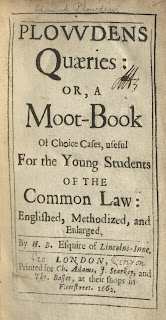The Riesenfeld Center holds an interesting range of works on early American criminal law. Some of these highlight new approaches to crime and punishment in the colonies and early republic. The material offers food for thought on the history of American criminology and penology, and reveals trends that influenced philosophical shifts in the later 18th century, particularly around Philadelphia, which found itself at the forefront of innovation.
England's criminal laws featured more than 200 capital offenses by the late 18th century and had a natural influence in early America. Penalties in the colonies were also harsh, even if executions were less frequent, due to a smaller population and a more inchoate legal administration, and in some places more restrictive statutes and interpretation. In the colonies and under English common law, public shaming, including wearing a visible letter, bearing a permanent mark of the crime, or being kept in a pillory or stocks, was not uncommon, together with whipping. Fairly steep fines for lesser offenses were also common.
Prisons had a long history by then, but the movement toward prisons as a particular supervisory system supported by theories of work and rehabilitation coalesced around practical and religious concerns. In early modern England, workhouse prisons were constructed for individuals considered the "idle poor," to make them more productive. The movement was strengthened by a religious belief that vagrants and the idle, as well as certain criminals with whom they were often grouped, could be morally improved by work in a disciplined setting. Still, not unusually, early prisons threatened the lives of their inmates with unsanitary conditions, neglect and worse.
In early America, Quakers were leading voices for moral rehabilitation. In Quaker William Penn's "Frame of Government" for Pennsylvania of 1682, the outlined penal regime provided that "all prisons shall be workhouses for felons, vagrants, and loose and idle person; whereof one shall be in every county." Another clause had it that "all prisons shall be free, as to fees, food and lodging," taking aim at practices that tended to the extortion of inmates. Penn's workhouse provision for felons was significant in a legal system that prescribed hanging for felonies. In the first statutes passed by Penn's assembly in 1682, death was decreed only for murder, though the colonial assembly's moderate criminal laws were rejected by the English government. Felons in the colonies, however, as in England, sometimes got off more lightly for first offenses. They availed themselves where they could of "benefit of clergy," even as laymen, and could receive a lesser penalty (often branding). This legal fiction, along with pardons, sometimes mitigated the harshest criminal penalties.
The Enlightenment also contributed new strands of thought. Most importantly, the Milanese jurist Cesare Beccaria (1738-1794), in his famous Essay on Crimes and Punishments in 1764, deeply questioned the rationality and efficacy of the death penalty and judicial torture, and argued that penalties must be made proportionate to crimes. Punishment beyond what was strictly necessary was tyranny. Beccaria's work was quickly translated from Italian and became an instant classic in Europe. As Professor John Bessler has demonstrated, the Essay also had a profound impact in the colonies, where it was read by the likes of Adams and Jefferson. In attempting to reform Virginia laws in 1776, Jefferson proposed a bill that would allow the death penalty only in cases of murder or treason; it was defeated by one vote. Some states at least adopted language in their early constitutions that sought to reduce and avoid "sanguinary laws."
Criminal law reform and prison reform were enduring issues in the early republic. One center of innovation was Philadelphia, where strands of Enlightenment and Quaker reformist thought met. There leading intellectuals, like James Wilson and Benjamin Rush, inveighed against harsh punishments, particularly the death penalty, and pressed on arguments for greater proportionality. Philadelphia's Walnut Street Prison became an early experiment in a new penology. Built in 1773, it was modified in 1790 to treat serious felons (who were subject earlier to the death penalty) to solitary confinement. This was the original idea behind a "penitentiary." The Quakers who championed the project thought that intense personal reflection would lead to repentance and moral rehabilitation, and were ignorant of the damage caused by isolation.
Visitors to the prison, like Robert Turnbull in A Visit to the Philadelphia Prison (1796), observed work done in skilled workshops of "carpenters, joiners, turners, shoemakers, weavers and taylors," whose maintenance was paid for by the profit of their labor. Turnbull praised the system and the newly sanitary conditions, but noted the silence imposed on prisoners and the extent of prison segregation. In his On the Prisons of Philadelphia (1796), European observer the Duc de la Rochefoucauld (1747-1827) lauded the absence of physical punishment from guards or violence between inmates. He found the meals, which included meat, commendable, and explained a system whereby those judged as rehabilitated by overseers were released with some money from their labor. Despite the praise, the system was draconian in new ways. But it appealed to contemporaries and influenced the design of many other prisons, being later partly modified by the "Auburn system," which shared similar features.
These and other works permit some comparison of these systems in their idealized forms, and show development, decay, variations, criticism, and legislation that attempted further reforms. Recent work sheds good light on these issues of early American criminology and criminal law reform, including several below:
Bessler, John D. The Celebrated Marquis: An Italian Noble and the Making of the Modern World. Durham, N.C.: Carolina Academic Press, 2018; and idem, The Baron and the Marquis: Liberty, Tyranny, and the Enlightenment Maxim That Can Remake American Criminal Justice. Durham, N.C.: Carolina Academic Press, 2019.
Rubin, Ashley T. The Deviant Prison: Philadelphia's Eastern State Penitentiary and the Origins of America's Modern Penal System, 1829-1913. Cambridge: Cambridge UP, 2021.
Shapiro, David M. "Solitary Confinement in the Young Republic." Harvard Law Review 133, no. 2 (2019): 542-98.
- Ryan Greenwood, Curator of Rare Books and Special Collections





































